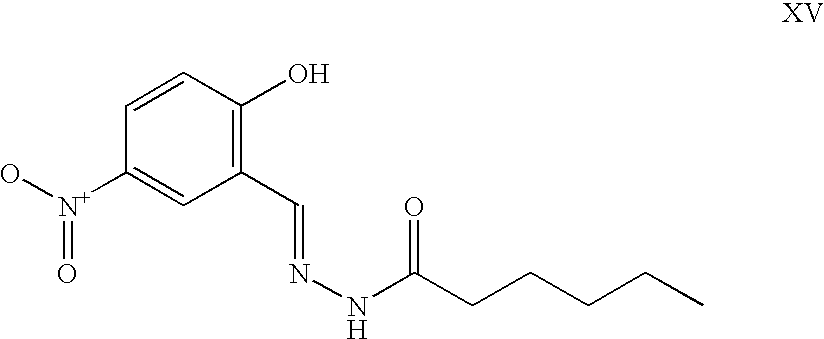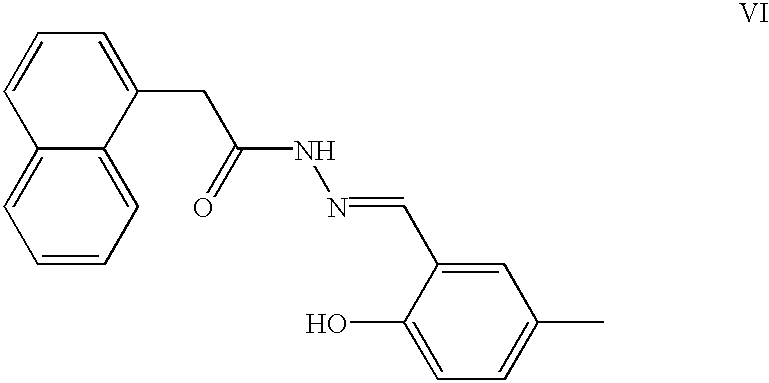Genetic and epigenetic manipulation of ABC transporters and ecto-phosphatases
a technology of ectophosphatases and transporters, applied in the field of gene and epigenetic manipulation of abc transporters and ectophosphatases, can solve the problems of skepticism of atp channel hypothesis, no subsequent publications addressing or explaining this effect, and no precise molecular-level description of the mechanism by which over-expression lowers intracellular accumulation of drugs
- Summary
- Abstract
- Description
- Claims
- Application Information
AI Technical Summary
Problems solved by technology
Method used
Image
Examples
example 1
Inhibition of Antibiotic Resistant Bacteria With Ectophosphatase Inhibitors
A. Summary of Protocol and Results
[0119] The purpose of this study was to evaluate various ectophosphatase inhibitor compounds for any potentiating effect or resistance reversal with methicillin resistant Staphylococcus aureus (MRSA). Two strains of Staphylococcus aureus were obtained from the American Type Culture Collection (ATCC). Those obtained were a previously characterized methicillin resistant strain (# 43300) and a previously characterized methicillin sensitive strain (# 29213) to serve as a control. Strains were received as lyophilized pellets and were rehydrated according to the ATCC Product Information Sheet using Trypticase Soy Broth.
[0120] Mueller-Hinton agar plates were prepared containing 1 of 6 inhibitor compounds investigated. The compounds were dissolved in DMSO at concentrations of 20 mg / ml. 25 .mu.l of this stock solution was added to 25 mls of media just prior to cooling to solidificatio...
example 2
Inhibition of Chemotherapy-Resistant Tumor Cells With An Ecto-Phosphatase Inhibitor
[0126] In order to determine the effect of ecto-phosphatase inhibitors on tumor cells resistant to a chemotherapeutic agent, 2 breast cancer tumor cell lines were tested, a vinblastine resistant line (SW-13Vb003) and its vinblastine sensitive parent line, SW-13. A standard 4 day incubation at 37.degree. C. and 5% CO.sub.2 was used. IC.sub.50 tests (MTT) were done using standard methodology in 96 well plate format with inhibitor concentrations ranging from 0-90 .mu.g / ml (DMEM media). Results showed that 3 of the inhibitor compounds tested, NGXT194 (Formula VI), NGXT196 (Formula VIII), and NGXT1915 (Formula X), produced lower IC.sub.50 values with the resistant cell line than with the sensitive line. For NGXT194, SW-13 was sensitive at 20 .mu.g / ml, whereas the vinblastine resistant line SW-13Vb003 was sensitive at 10 .mu.g / ml. For NGXT196, SW-13 was sensitive at 30 .mu.g / ml, whereas the vinblastine resi...
example 3
Over-Expression of Ecto-Phosphatase Does Not Increase the Cellular Uptake of Adenosine
A. Materials and Methods
[0128] Transgenic Plant Construction: psNTP9 (Pisum Sativum apyrase, GenBank accession #Z32743) was subcloned as a Sall to Xbal fragment into pKYLX71 (Schardl et al, 1987, supra). This plasmid was transformed into A. tumefaciens GV3101 [pMP90] pKYLX71 (Koncz and Shell, 1986), which was used to infect root call from Ws ecotype Arabidopsis thaliana under kanamycin selection (Valvekens et al., 1992). Four individual lines, obtained from separate calli, were propagated to the third generation (T3).
[0129] Subcellular Apyrase Distribution in Pea: Etiolated pea plumules served as the tissue source for nuclei and cytoplasm isolation as described by Chen and Roux (Plant Physiol. 81:609-612 (1986)). Plasma membrane was prepared from 30 g of pea root tissue (Zhu Mei Jun and Chen Jia; 1995, Acta Botanica Sinica 37:942-949). Western analysis was performed on 15-30 pg of protein from cyto...
PUM
| Property | Measurement | Unit |
|---|---|---|
| concentrations | aaaaa | aaaaa |
| concentrations | aaaaa | aaaaa |
| concentrations | aaaaa | aaaaa |
Abstract
Description
Claims
Application Information
 Login to View More
Login to View More - R&D
- Intellectual Property
- Life Sciences
- Materials
- Tech Scout
- Unparalleled Data Quality
- Higher Quality Content
- 60% Fewer Hallucinations
Browse by: Latest US Patents, China's latest patents, Technical Efficacy Thesaurus, Application Domain, Technology Topic, Popular Technical Reports.
© 2025 PatSnap. All rights reserved.Legal|Privacy policy|Modern Slavery Act Transparency Statement|Sitemap|About US| Contact US: help@patsnap.com



